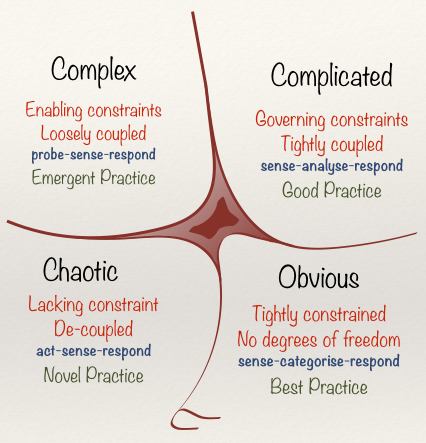First Principles over Best Practices

Why the future belongs to the naive
My first project in marketing was a 60-slide analysis of competing websites. My boss had the intuition that a website should explain benefits and values of solving the problem, rather than a checklist of features. And he was right, but the CMO would only accept proof of best practice.
Best practice. What is best practice? It turns out best practice fits cleanly in the Cynefin framework under the “Obvious” or “Simple” domain of problems.
Problems in this domain are actually quite rare, at less than 10 percent, but solutions are probably closer to 30 percent in this domain. We seem to love best practices as a species, or at least an industrialized monoculture of wage slaves.
But Software is eating the Obvious. What remains are complicated problems (in product) and complex problems (in marketing).
Many recent disruptive innovations have come about because of industries stuck with best practices:
- The shoe retail industry was stuck with problems of customer service and inventory management best practices: Zappos disrupted them by offering high quality, script-free customer service and more inventory.
- The space industry was stuck with problems of supply chain best practices: SpaceX succeeded by identifying the true costs of space travel materials to be less than 10% of this best practice.
- The hotel industry was stuck with problems of pricing and inventory best practices: Airbnb disrupted this by creating flexible inventory and a reason to justify dynamic pricing.
- The pharma industry was stuck with the best practice of focusing on R&D and real products: Theranos disrupted this by instead relying on vaporware.
- Retailers were stuck with an imposed best practice of never charging extra to use a credit card: Arco gas broke this by daring to offer a lower price for cash and only accepting debit transactions.
- The insurance industry was stuck with the best practice to rely on agent intermediaries to acquire customers: Zenefits disrupted this by instead offering their software for free to acquire customers.
- The taxi industry was stuck with the best practice to encourage a balkanized market of vendors with consistent pricing: Uber disrupted this by aggregating drivers into one marketplace and adjusting pricing to meet demand.
For these reasons, I cringe when I hear someone rely on best practices.
Not everything should be done in an original way, of course: there is little benefit to innovate on your choice of CMS (Wordpress) or Email (Google or Exchange) or basic marketing collateral (business cards, brochure, website, etc.)
These decisions are simple and obvious; best practices are best.
But actually most of B2B marketing is more appropriately situated in the Complex domain, where Emergent Practice wins over Best Practice.
- Should you send a regular newsletter? Yes, this is best practice. But the right content and timing will be a dynamic decision based in part on the other emails you compete against for the inbox.
- Should you use outbound email and calls? Yes, this is best practice. What script should you use? This is not a static decision, but must be reviewed on a regular basis to ensure your templates are still effective.
- Should you blog? Best practice. What should you blog about? It was listicles in 2015, but now its 2,000 word minimum posts.
In most complex domains, there is a complicated solution that can solve the problem in a superior manner; a trump card.
The stock market, for example, is an incredibly complex domain. Inside trading is a superior method to win in the domain; the punishment for inside trading exists to maintain the complex dynamic of the market.
Inside trading persists, however, because of a network of trust that is not easily broken.
In marketing, the trump cards are also based on trust. Most of branding and advertising exists to promise that your company is healthy and will not disappear tomorrow. A service-oriented sales process will succeed because it implicitly promises a service-oriented outcome after the signature. Instagram product endorsements are killing it right now because these microcelebrities have established deep trust with their audiences.
Gaining trust in high ASP, B2B marketing is not easy, but there may be one clear play: conspicuous personalization.
Conspicuous personalization is the act of personalizing your communication in a way that proves you are not a robot.
Conspicuous personalization doesn’t mean you write in your email “I did some research about your company and” but instead you find something that clearly you researched which relates to the buyer.
Conspicuous personalization doesn’t mean you personalize your website to target specific accounts; it means you customize your content offers to be relevant to each target account.
Conspicuous personalization doesn’t mean you send your emails on Tuesday because thats what some vendor says to do; it means you send your emails on Sunday morning, or during the winter holiday, because you know your competition will not.
Conspicuous personalization doesn’t mean you name your recipient in the subject line; it means you mention their company in paragraph four, after they’ve already started reading, and then you further personalize from there.
To paraphrase JFK: you should choose to implement conspicuous personalization and other trump cards not because they are easy, but because they are hard.